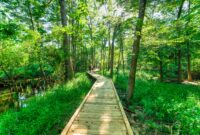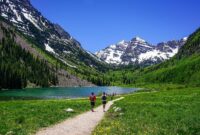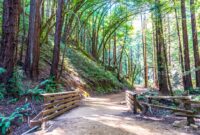Trails and hikes near me offer a wealth of opportunities for exploration and recreation. Whether you’re a seasoned hiker seeking challenging climbs or a casual walker looking for a peaceful stroll, the natural world surrounding you holds countless possibilities. This guide helps you discover local trails, understand their difficulty levels, and plan safe and enjoyable outings, catering to various fitness levels and preferences.
From finding reliable information sources to understanding the nuances of trail descriptions and safety considerations, we’ll equip you with the knowledge and tools to confidently embark on your next adventure. We’ll also explore interactive map features and user reviews, highlighting how technology can enhance your hiking experience.
Local Trail Information Gathering
Locating reliable information about local trails is crucial for planning safe and enjoyable hiking experiences. This involves utilizing a variety of data sources and organizing the collected information in a clear and accessible manner. Effective categorization and a system for evaluating data accuracy further enhance the planning process.
Data Sources for Finding Local Trails
Several resources provide comprehensive information on local trails. These include government websites dedicated to parks and recreation, popular mapping applications with hiking features, and dedicated hiking blogs and websites maintained by enthusiasts and experienced hikers. Government websites often offer detailed trail maps, descriptions, and regulations. Mapping applications provide interactive maps, elevation profiles, and user reviews. Hiking blogs offer personal experiences, trail condition updates, and photographic documentation.
Structuring Trail Information in a User-Friendly Format
Presenting collected trail data in a structured format improves accessibility and usability. An HTML table is an effective method for organizing this information. The table below demonstrates a user-friendly format with four responsive columns: Trail Name, Distance, Difficulty, and Location.
| Trail Name | Distance (miles) | Difficulty | Location |
|---|---|---|---|
| Eagle Peak Trail | 5.2 | Moderate | Rocky Mountain National Park |
| Whispering Pines Loop | 2.7 | Easy | Big Basin Redwoods State Park |
| Granite Canyon Trail | 8.1 | Strenuous | Yosemite National Park |
| Riverwalk Trail | 1.5 | Easy | Downtown Riverfront Park |
Categorizing Trails
Categorizing trails based on factors such as difficulty, length, and scenery type enhances search and filtering capabilities. A multi-faceted categorization system allows users to quickly find trails that match their preferences and abilities. For example, trails could be categorized by difficulty level (Easy, Moderate, Strenuous, Expert), length (Short, Medium, Long), and scenery type (Forest, Mountain, Desert, Coastal). A trail could then be classified as “Moderate, Medium, Forest” allowing for efficient filtering.
Evaluating the Reliability and Accuracy of Information
Cross-referencing information from multiple sources is key to verifying accuracy. Comparing data points across government websites, mapping applications, and hiking blogs helps identify discrepancies and inconsistencies. Consider the source’s reputation, the recency of the information, and the presence of supporting evidence (e.g., photographs, user reviews) when assessing reliability. For example, a trail length reported consistently across three different sources is more reliable than a length reported only on a single, less established blog.
Visual Presentation of Trail Data
Effective visual presentation is crucial for enhancing user engagement and providing a clear understanding of trail information. A well-designed interface should seamlessly integrate various visual elements to offer a comprehensive and intuitive experience. This includes the use of maps, photographs, elevation profiles, and illustrative icons.
Trail Maps and Photographs
High-quality maps are essential for navigation. Interactive maps, allowing users to zoom, pan, and view points of interest, are highly desirable. These maps should clearly indicate the trail route, elevation changes, and points of interest such as viewpoints, water sources, or campsites. Furthermore, incorporating photographs at key locations along the trail provides a realistic preview of the scenery and trail conditions. For example, a photograph of a particularly steep section could help users prepare for a challenging climb. Images should be high-resolution and showcase the trail’s environment accurately.
Elevation Profile Representation
An elevation profile visually represents the changes in elevation along a trail. This allows users to quickly assess the difficulty level and plan accordingly. A text-based representation could use characters to illustrate the incline and decline. For example:
“`
Trail Elevation Profile: Easy Loop Trail
Start (0m) _ _ _ _ / \ _ _ _ _ \ _ _ _ \ (100m) _ _ _ _ / \ _ _ _ _ / (150m)
\ / \ / \ /
\ / \ / \ /
\ / \ / \ /
\ / \ / \ /
X X X
/ \ / \ / \
/ \ / \ / \
/ \ / \ / \
/ \ / \ / \
End (0m) _ _ _ _ \ _ _ _ _ \ _ _ _ _ \ _ _ _ _ /
/ represents incline; \ represents decline; X represents a relatively flat section.
“`
Trail Scenery Descriptions
Detailed descriptions of trail scenery enhance the user experience. Sensory details are key to conveying the atmosphere.
Forest Trail Scenery
Imagine walking through a lush forest, sunlight dappling through the leaves, creating a mosaic of light and shadow on the forest floor. The air is cool and damp, carrying the scent of pine needles and damp earth. The sounds of birdsong and rustling leaves create a tranquil ambiance. The path is shaded and relatively cool, with the occasional glimpse of sunlight illuminating patches of wildflowers.
Mountain Trail Scenery
A mountain trail offers breathtaking panoramic views. The air is crisp and thin, carrying the scent of pine and wildflowers. The trail is exposed, with the sun beating down. The sounds of wind whistling through the rocks and the distant call of a hawk fill the air. The terrain is rocky and uneven, with steep inclines and challenging climbs.
Coastal Trail Scenery
A coastal trail offers the invigorating scent of salt and sea spray. The sound of crashing waves provides a constant, rhythmic soundtrack. The path is often exposed, with the sun reflecting off the water and sand. The view is constantly changing, with glimpses of dramatic cliffs, sandy beaches, and the vast expanse of the ocean. Seabirds cry overhead, adding to the dynamic and vibrant atmosphere.
Trail Information Icons
Icons are useful for quickly conveying key information. For instance:
* Difficulty Level: A simple mountain icon with varying numbers of peaks could represent easy, moderate, or difficult trails.
* Water Sources: A water droplet icon indicates the presence of a water source along the trail.
* Trail Markers: A trail marker icon shows the presence of well-marked trails.
* Rest Areas: A picnic table icon denotes designated rest areas.
* Wildlife: An animal icon could alert hikers to the presence of certain wildlife in the area.
Last Point
Exploring trails and hikes near you offers a unique blend of physical activity, scenic beauty, and a chance to connect with nature. By utilizing the resources and information provided in this guide, you can easily discover, plan, and enjoy a variety of hiking experiences tailored to your individual needs and preferences. Remember to always prioritize safety and respect the environment while exploring the trails around you.




